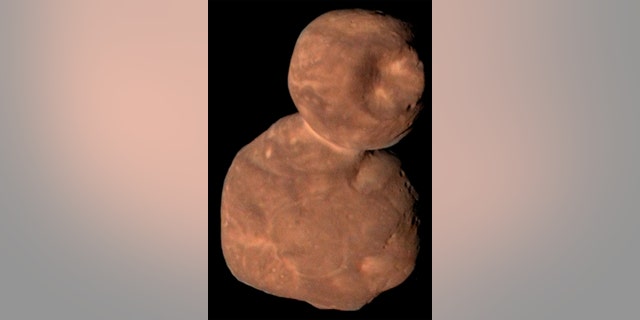NASA has renamed the most distant object ever explored, the mysterious Ultima Thule, after controversy arose that its name was linked to the Nazi party.
Previously known as "2014 MU69," the celestial object was given the informal name of Ultima Thule by the New Horizons team, after a mythical northern land in classical and medieval European literature, according to Science Alert. However, the Thule Society, founded in 1918, was also the name of a German occultist group that would later evolve into the Nazi party.
NASA has since renamed the object as Arrokoth, a Native American term meaning "sky" in the Powhatan/Algonquian language, after getting consent from elders in the Powhatan Tribe.

Composite image of primordial contact binary Kuiper Belt Object 2014 MU69 from New Horizons Spacecraft Data. (Credit: NASA)
"The name 'Arrokoth' reflects the inspiration of looking to the skies, and wondering about the stars and worlds beyond our own," said Alan Stern, New Horizons principal investigator from Southwest Research Institute, in a statement. "That desire to learn is at the heart of the New Horizons mission, and we're honored to join with the Powhatan community and people of Maryland in this celebration of discovery."
Stern did not reference the link to the Thule Society as a reason for the new name, but did mention it during a press conference. "Just because some bad guys once liked that term, we’re not going to let them hijack it," Stern said, according to The Independent. Ultima Thule is also the name of a Swedish rock group that has been alleged to be racist, a claim the band has publicly denied on its website.
The new official name was ratified by the International Astronomical Union and announced at a ceremony on Tuesday at NASA's headquarters in Washington.
"The team for NASA’s New Horizons mission intended for Ultima Thule – representing the concept, 'beyond the limits of the known world' – to be a temporary nickname, and planned to propose a permanent name after the flyby," NASA spokesman Allard Beutel told Fox News via email. "The team chose the Algonquian/Powhatan word Arrokoth as a tribute to the indigenous peoples of the region critical to the discovery and exploration of the farthest object ever encountered by spacecraft."
Lori Glaze, director of NASA’s Planetary Science Division, said they "graciously accept[ed]" the gift of the Arrokoth name from the Powhatan people.
“Bestowing the name Arrokoth signifies the strength and endurance of the indigenous Algonquian people of the Chesapeake region," Glaze added in the statement. "Their heritage continues to be a guiding light for all who search for meaning and understanding of the origins of the universe and the celestial connection of humanity.”
The Southwest Research Institute's Marc Buie said the discovery of Arrokoth, located in the Kuiper Belt, an area of icy bodies far past Neptune and 4 billion miles from Earth, has aided astronomers in understanding the universe.
MISSING LINK FOUND? MYSTERIOUS SPACE ROCK MAY PROVIDE CLUES TO HOW PLANETS FORM
"Data from the newly-named Arrokoth, has given us clues about the formation of planets and our cosmic origins," said Buie in the statement. "We believe this ancient body, composed of two distinct lobes that merged into one entity, may harbor answers that contribute to our understanding of the origin of life on Earth."
The mysterious 22-mile-long object (which may have formed after two lobes orbited each other) has previously been described by NASA as a "giant pancake" and "a dented walnut," after the space agency originally thought it looked like a reddish snowman.
In May, NASA revealed a startling discovery that there are both water and "organic molecules" on its surface. It is considered to be the "reddest outer solar system object ever visited by spacecraft," likely due to organic molecules on the surface that have contributed to its vibrant color.
Scientists have also found new features on Arrokoth, including several bright spots, patches and craters, including a 5-mile-wide depression that likely formed from some kind of impact. Traveling at roughly 33,000 miles per hour, the $720 million New Horizons spacecraft, which launched in January 2006, will continue sending data transmission from its Arrokoth flyby until the latter part of summer 2020.
CLICK HERE TO GET THE FOX NEWS APP
https://www.foxnews.com/science/nasa-renames-ultima-thule-nazi-controversyBagikan Berita Ini















0 Response to "NASA renames mysterious Ultima Thule after Nazi controversy arises - Fox News"
Post a Comment